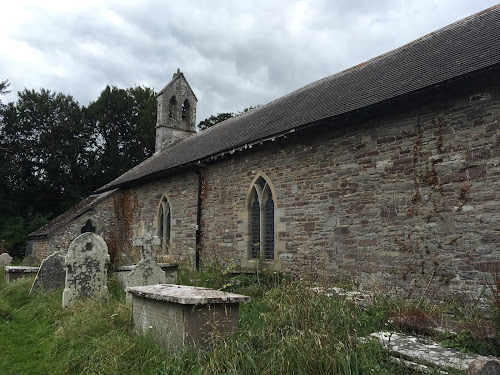On our journey back to the Infernal City we stopped briefly at Llanspyddid, between Brecon and Sennybridge (that whole valley of the Usk being some of the most beautiful countryside in Britain) so that I could photograph the church having noted, every time we pass by in the car, how beautifully it sits in its surroundings. An ancient place, dedicated to an early abbot of the monastery at Llancarfan in the Vale of Glamorgan. That picturesque quality is aided, I think, by the yew trees in the graveyard - the Ancient Yew Group has a system for classifying old yews: Ancient, Venerable and Notable and according to the The New Naturalist Library 'Brecon Beacons' edition (2014) Llanspyddid has one example of each. I didn't count how many yews are currently growing there (7/8 apparently), but there were once more: Edwin Poole in 'The Illustrated History and Biography of Brecknockshire',1886, mentions fourteen.
Alas, on closer inspection it was all a bit of a disappointment - the church an orchestral player not a soloist. Its interest scenic rather than architectural. The graveyard is a mess - a visitor would be hard placed to find the pillar stone of the 7th-9th century AD that is traditionally said to commemorate Aulach, father of Brychan the founder of the ancient kingdom of Brycheiniog. And, to be honest, the church is somewhat lacking in interest. Not only was it closed but had the air of being abandoned. That said the porch, which by the looks of it was originally all of timber, and the little Victorian bell turret make a nice composition, but on the whole the church is somewhat dull. A simple unicameral structure like a Medieval church in rural Scotland. I suppose you could make the argument that St Cadog is a good example of how an ancient building, grown up in harmony with its surroundings, can fall foul of Modernity, and be left reeling. It suffered a restoration in 1886 at the hands of Charles Buckeridge of Oxford, though Edwin Poole praised it highly enough. Buckeridge who restored quite a number of churches in Breconshire, about twelve in all, was a pupil of George Gilbert Scott and heavily influenced by George Edmund Street, so you would think he might know better, though judging by Street's assault on North Luffenham church, perhaps not. The odd bit of research on the internet suggests that it did retain its Tilestone roof until the second half of the 20th century when it was replaced with artificial plain tiles. Artificial!! Buckeridge deserves some credit therefore for its retention at the time, when he could have easily swept it away and replaced it with slate. I suppose in its previous state the church must have resembled, somewhat, St James in Kinnersley. Buckeridge's bellcote is fine, but as for his east window the least said the better. And now, with the continuing decline in religious observance, indifference is completing the work.
I'm not a fan of comprehensive restorations - they tend to sweep too much away in the process, and after all an ancient structure such as this is an accretion of things, a layering of history, in which for good or ill each part has as a role to play. However here I would be willing to make an exception seeing Llanspyddid as a place that needs an 'unrestoration', a careful unpicking of Modernity.
Richard Hall, (1817-1866), the local poet is buried in the churchyard.



No comments:
Post a Comment